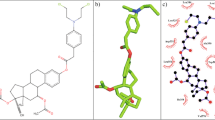Summary
The estrogen receptor that is present in many breast tumors provides a mechanism for the concentration of estrogens. Hence, it should be possible to effect a selective, receptor-mediated killing of estrogen receptor-rich tumor cells with a suitable cytotoxic estrogen derivative. Because the dose per cell that can be delivered by a receptor-mediated process is limited by the capacity of the estrogen receptor system (ca. 1,000–10,000 molecules per cell), the cytotoxic moiety of these derivatives needs to be directed at a target where an effective cell kill can be achieved with this limited dose; DNA appears to be the most suitable target. The estrogen derivatives that contain DNA-alkylating and cross-linking groups and retain high affinity for the estrogen receptor should be carried selectively to the nucleus. There, it is hoped that they would react with DNA with reasonable efficiency. Definitive tests of receptor-mediated cytotoxicity in vitro could be performed in cultures of human breast tumor cells that are receptor positive (e.g., MCF-7) or receptor negative (e.g., MDA-MB-231). These tests would involve comparison of the potency of the cytotoxic estrogens with that of cytotoxic control compounds, both in the presence and absence of estradiol, in order to correct for possible differences in the sensitivity of the different cell lines to cytotoxic agents and to metabolic effects of estradiol. These agents would then be tested in experimental mammary tumor systems in the rat. Our current understanding of the characteristics of estrogen receptor binding, and the availability of suitable systems for studying these agents in vitro and in vivo, make a definitive test of selective cytotoxicity, mediated by the estrogen receptor, a timely and sensible endeavor.
Similar content being viewed by others
References
Thompson EB, Lippman ME (eds): Steroid Receptors and the Management of Cancer, Vol 1. CRC Press, 1979.
Katzenellenbogen JA, Heiman DF, Carlson KE, Lloyd JE: In vivo and in vitro steroid receptor assays in the design of estrogen pharmaceuticals.In Receptor Binding Radiotracers (WC Eckelman, volume editor) Vol 1, Chapter 6 (pp 93–126), CRC Press, 1982.
Muggia FM (ed): Reports from the workshop on the use of steroids as carriers of cytotoxic agents in breast cancer. Cancer Treat Rep 62: 1239–1268, 1978.
Raus J, Martens H, Leclercq G (eds): Cytotoxic Estrogens in Hormone Receptive Tumors. Academic Press, London, 1980.
Leclercq G, Heuson JC: Drug interaction with estrogen receptors for the control of breast neoplasia (Review). Anticancer Res 1: 217–228, 1981.
Allegra JC, Lippman ME, Thompson EB, Simon R, Barlock A, Green L, Huff KK, Do HMT, Aitken SC: Distribution, frequency, and quantitative analysis of estrogen, progesterone, androgen and glucocorticoid receptors in human breast cancer. Cancer Res 39: 1447–1454, 1979.
Kaufman RJ, Bertino JR, Schimke RT: Quantitation of dihydrofolate reductase in individual parental and methotrexate-resistant murine cells. J Biol Chem 253: 5852–5860, 1978.
Washtien WL, Santi DV: Assay of intracellular free and macromolecularbound metabolites of 5-fluorodeoxyuridine and 5-fluorouracil. Cancer Res 39: 3397–3403, 1979.
Gill DM, Katzenellenbogen JA: Hybrid toxins and their receptors: a workshop summary. J Cellular Biochem, in press.
Bloomer WD, Adelstein SJ: 5-(125I)-Iododeoxyuridine and the Auger effect: biological consequences and implications for therapy. Pathobiology Annual 8: 407–421, 1978.
Bloomer WD, McLaughlin WH, Weichselbaum RR, Tonnesen GL, Hellman S, Seitz DE, Hanson RN, Adelstein SJ, Rosner AL, Burstein NA, Nove JJ, Little JB: Iodine-125 labeled tamoxifen is differentially cytotoxic to cells containing oestrogen receptors. Int J Radiat Biol 38: 197–202, 1980.
Lippman ME, Bronzert DA, Hochberg RA: [125I] Iodoestradiol is specifically cytotoxic for estrogen responsive breast cancers (Abstract). J Cellular Biochem Suppl 6: 132, 1982.
Katzenellenbogen JA, McElvany KD, Senderoff SG, Carlson KE, Landvatter SW, Welch MJ: 16α-[77Br]-Bromo-11β-methoxyestradiol-17β. A gamma emitting estrogen imaging agent with high uptake and retention by target organs. J Nucl Med 23: 411–419, 1982.
Katzenellenbogen JA, Johnson HJ Jr, Carlson KE, Myers HN: The photoreactivity of some light-sensitive estrogen derivatives. The use of an exchange assay to determine their photointeraction with the rat uterine estrogen binding protein. Biochemistry 13: 2986–2994, 1974.
Lown JN, Joshua AV, McLaughlin LW: Novel antitumor nitrosoureas and related compounds and their reactions with DNA. J Med Chem 23: 798–805, 1980.
Robertson DW, Lwi LL, Hayes JR, Carlson KE, Katzenellenbogen JA, Katzenellenbogen BS: Tamoxifen aziridines: effective inactivators of the estrogen receptor. Endocrinology 109: 1298–1300, 1981.
Katzenellenbogen JA, Carlson KE, Heiman DF, Robertson DW, Wei LM, Katzenellenbogen BS: Efficient and highly selective covalent labeling of the estrogen receptor with3Htamoxifen aziridine. Biochemistry, submitted.
Author information
Authors and Affiliations
Rights and permissions
About this article
Cite this article
Katzenellenbogen, J.A., Katzenellenbogen, B.S. Considerations in the design and evaluation of cytotoxic estrogens. Breast Cancer Res Tr 2, 347–353 (1982). https://doi.org/10.1007/BF01805876
Issue Date:
DOI: https://doi.org/10.1007/BF01805876




